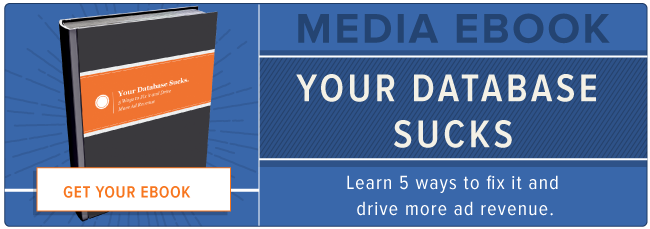

Publishers have faced several challenges with the explosion of digital media over the past ten years. Perhaps largest on that list are the many audience data silos that have popped up here and there and everywhere.
Many companies have their print magazine subscriber data files in an in-house fulfillment management system or an outside fulfillment house. Digital magazine subscriber data is usually housed with multiple outside vendors. Email newsletter lists are often in an outside email service provider. Event attendees are likely on a spreadsheet in the marketing department. And, any lists generated by editorial might be on word documents on the editor’s computer.
Yikes.
These disparate databases are daunting not only because of the tedious manual tasks they create, but because they’re also a barrier to the monetization of your digital audience. Despite the challenge this presents, the opportunity here is HUGE if you can wrangle together a system that combines these silos into one unified database.
Before you start smashing information together in hopes that a pretty picture will emerge, you'll need a strategy to get your data ready to talk to each other, collect funnel data, and ultimately drive marketing efforts automatically.
Here are some tips to help you build a powerful unified database.
Grow Your Email Database by 4x
The email address is the key to digital interactions. When you know your readers’ email addresses you can increase the quantity and quality of your marketing outreach, all while spending less money than you would using traditional methods like direct mail or print ads.
Aside from just knowing a reader’s email address, when you unify your database, you can connect this vital piece of information with other data points they may already exist for customers. For example, identifying your print subscribers who also subscribe to your email newsletters, click on certain article topics, or have been to a specific event.
Take for example a actual regional magazine that started with 60,000 print subscriber records, of which 30,000 had email addresses. They also had 1,200 digital edition subscribers with email addresses. Plus they had a robust enewsletter program with six newsletters with 10,000 - 17,000 subscribers.
When these databases were unified and the audience silos removed, that data started talking and over 8,100 connections were made that didn’t exist before.
Not only did these connections lead to valuable intelligence about the customers, they created the potential for ongoing automated and hyper-targeted database marketing programs that generate a steady stream of new newsletter signups, digital subscriptions, print subscriptions and renewals of expired subscriptions.
Creating a Self-Growing Email List
Continuing to increase the number of email addresses in your database has immense value to you as a content company. From growing subscriptions for products like print and digital subscriptions and special interest publications, to selling event tickets, or providing value for advertisers—a large organically cultivated audience is crucial.
One example of how to grow the number of emails in your database that I love is, The Birthday Club. Put simple, you offer people a present from your publication on their birthday in exchange for their email information. This campaign not only grows your number of contacts but gains another very valuable data point, someone's birth date.
Outside of that promotion, there are endless content offers that publishers can use to acquire email info—newsletters, regional guides, product guides—you name it.
Identify Your Best Customers and Target Them to Increase Lifetime Value
A unified database can show you which customers are most valuable to your company by highlighting people who consume multiple products. Additionally, it can show you the most effective way to engage these high-value readers.
For example, If you have a customer who subscribes to your dining newsletter, attended two food events that you sponsored, and have visited 10 pages in the dining section of your website, you know that they are the perfect candidate for marketing a print subscription with a Best New Restaurants free ebook offer and workflow.
Get Conversions While You Sleep
Yes, it’s possible.
With your data unified, you can identify tasks that are typically done manually, and then create marketing automation workflows to generate those conversions automatically. Using your database to identify the combinations of products your audience tends to connect with, you can set up workflows that funnel users through to offers specifically targeted to them, based on previous actions taken on your site or purchase behavior.
For example, if you discover after unifying your database that 80% of your customers who subscribe to two email newsletters also have a digital magazine subscription, you know that setting up a workflow that automatically offers a digital subscription whenever a customer subscribes to a second email newsletter makes a lot of sense and is likely to have great success.
Deliver More Value to Your Advertisers With Audience Growth and Unprecedented Targeting
When you can tell a growth story in today’s marketplace advertisers really sit up and take notice. Even more so, growth that you can directly attribute to your marketing efforts and digital campaigns can set you apart from the thousands of other digital publications fighting for ad dollars. With a unified database, you are able to deliver value to your advertisers in the form of a consistently-analyzed and hyper-targeted audience, allowing you to develop much more creative advertising programs that your advertisers will love.
Tie these two pieces together and instead of a third party survey or study of engagement, use your own data to tell very specific stories that show actual detailed engagements (and growth) by your customers with your various products.
It may seem like a daunting challenge to tackle, but it's well worth the effort. A unified database along with marketing automation and a solid marketing strategy will not only help you grow your audience, but sell the value of that database to your advertisers.










